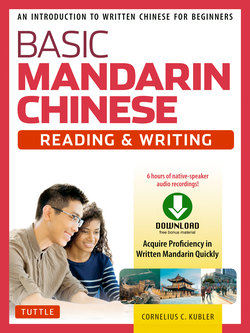Читать книгу Basic Mandarin Chinese - Reading & Writing Textbook - Cornelius C. Kubler - Страница 16
На сайте Литреса книга снята с продажи.
ОглавлениеPART 1
Personal Names, Place Names, People and Their Places of Origin
New Characters and Words
Study the six characters below and the common words written with them, paying careful attention to each character’s pronunciation, meaning, and structure, as well as similar-looking characters. After you’ve studied a character, turn to the Practice Book volume and practice writing it on the practice sheet, making sure to follow the correct stroke order and direction as you pronounce it out loud and think of its meaning.
| 25 | 上 | shàng | above |
| The radical, located at the very bottom of the character, is 一 yī (1), which here represents a base. The two strokes “above” that base signify “above.” | |||
| 26 | 海 | hăi | ocean, sea |
| Radical is 水 shuĭ “water.” Notice that this radical is written 氵 and is referred to colloquially as 三点水 (三點水) sāndiăn shuĭ “three drops of water” when it occurs at the left-hand side of a character. The other component is 每 mĕi “each.” | |||
| 上海 | Shànghăi | Shanghai [PW] | |
| 27 | 广(廣) | guăng | broad |
| Radical is 广 yăn “eaves” [BF]. This radical is referred to colloquially as 广字头 (廣字頭) guăngzìtóu “top made up of the character 广.” Phonetic is 黃 huáng “yellow.” 广 (廣) can itself serve as a phonetic, e.g., in 矿 (礦) kuàng as in 煤矿 (煤礦) méikuàng “coal mine.” | |||
| 28 | 州 | zhōu | state, district |
| Radical is 川 chuān “river” [BF] (38). 州 can itself serve as a phonetic, e.g., in 洲 zhōu “continent” [BF] as in 亚洲 (亞洲) Yàzhōu “Asia.” | |||
| 广州 (廣州) | Guăngzhōu | Guangzhou (capital of Guangdong Province, formerly spelled “Canton”) [PW] | |
| 29 | 东(東) | dōng | east |
| Radical of the simplified form is 一 yī “one” (1). Radical of the traditional form is 木 mù “tree” [BF], which is a picture of a tree and its branches. The other component in the traditional form is 日 rì “sun” [BF], a squared-off picture of the sun with a sun spot in it. Traditional character 東 is a compound ideograph, the explanation being that the “sun” can be seen through the “trees” as it rises in the “east.” 东 (東) can serve as a phonetic in other characters, e.g., 冻 (凍) dòng “freeze” and 栋 (棟) dòng (measure for houses). | |||
| 广东 (廣東) | Guăngdōng | Guangdong (province) [PW] | |
| 山东 (山東) | Shāndōng | Shandong (province) [PW] (lit. “east of the [Tàiháng] Mountains”) | |
| 台东 ( 台東 ) | Táidōng | Taitung (city on east coast of Taiwan) [PW] | |
| 东京 ( 東京 ) | Dōngjīng | Tokyo (capital of Japan) [PW] | |
| 30 | 人 | rén | person |
| 人 is itself a very common radical. It is a pictograph showing the two legs of a human being. The printed form of this character often appears with the two “legs” connected at the top, whereas in the handwritten form the left “leg” curves down from top to bottom but the right “leg” joins the left “leg” half of the way down. The word 人 can be added to many place words to indicate “a person from …” or “a native of ….” Contrast 人 with 八 bā (9), 大 dà (13), and 文 wén (21). | |||
| 人 | rén | person [N] | |
| 北京人 | Bĕijīng rén | person from Beijing [PH] | |
| 广东人 ( 廣東人 ) | Guăngdōng rén | person from Guangdong [PH] | |
| 上海人 | Shànghăi rén | person from Shanghai [PH] |
Reading Exercises (Simplified Characters)
Now practice reading the new characters and words for this lesson in context. Be sure to refer to the Notes at the end of this lesson, and make use of the accompanying audio disc to hear and practice correct pronunciation, phrasing, and intonation.
A. PERSONAL NAMES
Read out loud each of the following personal names.
一、林广海
二、王文
三、李东山
四、何海文
五、文明明
B. PLACE NAMES
Read out loud each of the following place names.
一、上海
二、广州
三、广东
四、山东
五、东京
六、台东
C. PEOPLE AND THEIR PLACES OF ORIGIN
Read out loud each of the following expressions, thinking of the meaning as you say it.
一、北京人
二、广东人
三、台北人
四、上海人
五、台中人
六、台东人
七、东京人
八、广州人
九、山东人
十、台山人
D. CHARACTER DIFFERENTIATION DRILLS
Distinguish carefully the following similar-looking characters, pronouncing each one out loud and thinking of its meaning.
一、人人人八八八
二、八八八人人人
三、人人人大大大
四、大大大人人人
五、人人人文文文
六、文文文人人人
七、八八人人大大文文
八、人大八大文人
Reading Exercises (Traditional Characters)
A. PERSONAL NAMES
Read out loud each of the following personal names.
B. PLACE NAMES
Read out loud each of the following place names.
C. PEOPLE AND THEIR PLACES OF ORIGIN
Read out loud each of the following expressions, thinking of the meaning as you say it.
D. CHARACTER DIFFERENTIATION DRILLS
Distinguish carefully the following similar-looking characters, pronouncing each one out loud and thinking of its meaning.
Notes
C2. Since Chinese nouns are often not marked for number (that is, don’t indicate singular or plural), an expression like 北京人 could mean either “a person from Beijing” or “people from Beijing.” The context would often make the meaning clear. In the case of 北京人, given an appropriate context, an additional interpretation is actually possible: “Peking man,” that is, Homo erectus pekinensis.
Restaurant sign in Macau (large characters read from right to left)
